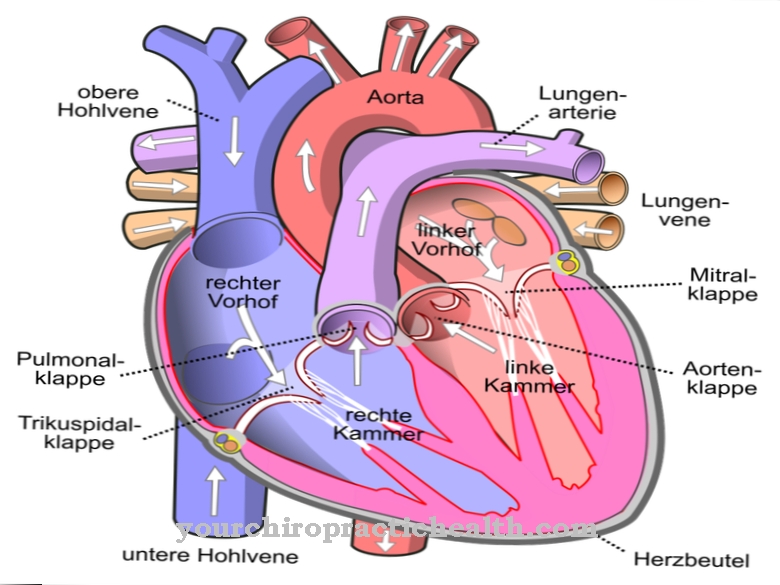As Ischium a part of the bony pelvis is known, which consists of the ischial body and two ischial branches. The ischium provides a starting point for many muscles and tendons. Because of this, in addition to fractures, it is sometimes affected by tendon and muscle diseases.
What is the ischium?
The ischium of most mammals actually corresponds to two ischial bones that together form the pelvic symphysis and thus contribute to the cartilaginous connection of the pelvic halves. In humans, too, the ischium is part of the bony pelvis and one of many flat bones in the body.
In the human organism, the ischium consists of the corpus ossi ischii, the ramus superior ossis ischii and the ramus interferior ossis ischii. The body of the os ischii belongs to the posterior part of the acetabulum and bears the caudal part of the major ischial notch, the flat bone spine of the ischial spine and the minor ischial notch on the posterior edge (margin).
The anatomy of the human ischium does not necessarily match the ischial anatomy of other mammals. In quadrupeds, for example, the spina ischiadica points upwards and has a groin shape. In the quadrupeds it is still part of the iliac bone. The ischium of most species has in common the caudal union of the ischial body and branches to form the ischial plate (tabula ossis ischii).
Anatomy & structure
Plate bones (Ossa plana) are flat bones with little thickness. On the outside, they consist of compact bone substance. Inside, they are made up of spongy bone substance that has bone marrow in between.
The bony pelvis (osi ischii) of humans contains such flat bones. It forms the arched lower limit of the so-called blocked hip hole (foramen obturatum). The bony pelvis is thickened towards the ischial tuberosity (ischial tuberosity). The ischial tuberosity is a muscle origin and an important seat point. It is covered by fat pads. The ischial spine (spina ischiadica) lies above the ischial tuberosity.
In the pelvic line, it divides into the major ischial incisura or the large ischial retraction and the minor ischial notch or small ischial retraction. Together with the iliac bone (os ilium) and the pubic bone (os pubis), the ischium forms the hip bone (os coxae). The os ischii is a single body with an upper and lower ischial branch. Some authors define the two branches as just one ischial branch. A multitude of muscles attach to the human ischium.
Function & tasks
Plate bones are mostly used for the mechanical protection of internal organs and, thanks to their flat shape, offer space for the insertion of the skeletal muscles. The function of the human ischium is, in addition to the insertion of muscles, primarily to stabilize the bony pelvis.
The upper ischial branch, together with the upper pubic branch, forms a cranial border for the foramen obturatum. This structure has three different sides: the so-called facies externa, facies interna and facies posterior. The facies externa is square and at the upper end bears the tendon of the obturator muscle externus in a sulcus. At the lower end it becomes the inferior ramus and thus receives stability. The anterior border of these structures is the obturator foramen. A prominent bone edge separates the structure from the posterior face. The quadratus femoris muscle has its origin near the edge. The fibers of the external obturator muscle lie in the anterior direction and the adductor magnus muscle arises in the downward direction.
The Facies interna forms part of the bony wall of the small pelvis on the upper ischial branch. The sickle-shaped extension of the sacrotuberous ligament can be seen on a sharp bone edge at the lower end. The transversus perinei superficialis muscle and the ischiocavernosus muscle also arise from the ischium. The ramus inferior ossis ischii is a flattened bone from the ramus superior. Together with the ramus inferior ossis pubis, it forms the caudal border of the foramen obturatum. The uneven external facies is the origin of the external obturator muscle and partly of the adductor magnus muscle.
The internal face, on the other hand, forms a part of the anterior wall of the small pelvis. The outer edge of this structure is the origin of the superficial perineum fascia (Fascia perinei superficialis). The inner fascia of the urogenital diaphragm is attached to the inner edge of the structure. In between, the transversus perinei profundus muscle has its origin.
You can find your medication here
➔ Medicines for painDiseases
Like any other bone in the body, the ischium can be affected by fractures. A fracture corresponds to the complete severing of a bone by direct or indirect force. Ischial fractures are either primary or secondary fractures.
In primary fractures, the bone fragments are no more than a millimeter apart. Secondary fractures have a fracture gap greater than one millimeter. A ischium fracture is usually preceded by falls or other accidents. A fatigue fracture of the ischium is also not uncommon after extreme stress. Since the anatomical structure of the ischium forms an attachment to a large number of tendons and muscles, muscle and tendon-related pain are the main cause of problems with the ischium.
For example, tendinitis on the ischial tendons is common. These usually occur due to friction, infections or overloading and are initially only expressed in mild complaints. Therefore tendinitis is often noticed very late and is then already characterized by crunching calcium deposits, which make treatment much more difficult. Muscle fiber tears with regard to the ischium are much less common than strains or muscle contusions. Inflammation of the muscles in the ischium is also rare, but it should not be completely ignored.


























